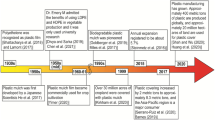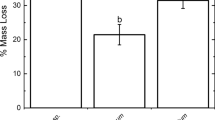Abstract
Hydrophilic-hydrophobic properties of organic matter and the content and distribution of water-soluble organic matter (WSOM) in soils of the Subpolar Urals are discussed. It is shown that the type of predominant vegetation in the system of altitudinal zones controls the amount and nature of soil organic matter (SOM). The litter of moss–lichen vegetation of the alpine tundra is enriched in hydrophobic compounds (up to 24.0%). In the grass communities of the subalpine zone, hydrophilic fractions of the SOM predominate (first fraction, 42.4–77.0%; second fraction, 0.3–12.6%). Woody vegetation of the mountainous forest zone is specified by an increased content of hydrophobic lignin-containing fractions (16.4–34.8%). Permafrost-affected soils of the alpine tundra are characterized by an increased hydromorphism leading to the accumulation of compounds associated with Fe and Al (up to 75.4%) in mineral horizons. The calculation of the WSOM carbon stock indicates that it reaches 0.3 to 9% of the total carbon stock in the soil profiles.





Similar content being viewed by others
REFERENCES
E. F. Vedrova and T. V. Reshetnikova, “Litter mass and intensity of litter decomposition in 40-year-old plantations of the main forest-forming species of Siberia,” Lesovedenie, No. 1, 42–50 (2014).
O. A. Vlasenko, “Dynamics of carbon of mobile humus in agrochernozem during spring wheat growing with the use of resource-saving technologies,” Vestn. Krasn. Gos. Agrar. Univ., No. 9, 60–65 (2015).
P. L. Gorchakovskii, Vegetation of the High-Altitude Urals (Nauka, Moscow, 1975) [in Russian].
S. V. Gubin, “Dynamics of the upper boundary of permafrost and humus retinization in tundra soils of the northeastern Russia,” in Proceedings of the IV All-Russian Conf. “Problems of Soil Evolution” (Pushchino, 2003), pp. 168–172.
G. V. Dobrovol’skii and I. S. Urusevskaya, Geography of Soils (Moscow State Univ., Moscow, 1984) [in Russian].
A. A. Dymov and N. A. Nizovtsev, “Amphiphilic properties of soil organic matter in dominant coniferous trees of the middle taiga,” Teor. Prikl. Ekol., No. 1, 62–68 (2015).
A. A. Dymov and E. Yu. Milanovskii, “Changes in the organic matter of taiga soils during the natural reafforestation after cutting in the middle taiga of the Komi Republic,” Eurasian Soil Sci. 46, 1164–1171 (2013). https://doi.org/10.1134/S1064229314010049
A. A. Dymov and E. Yu. Milanovskii, “Assessing the complexing properties of soil organic matter by IMAC (case study of copper ions),” Eurasian Soil Sci. 53, 178–186 (2020). https://doi.org/10.1134/S1064229320020040
A. A. Dymov, Soil Successions in Boreal Forests of the Komi Republic (GEOS, Moscow, 2020) [in Russian]. https://doi.org/10.34756/GEOS.2020.10.37828
F. R. Zaidel’man, Gleyzation and Its Role in Pedogenesis (Moscow State Univ., Moscow, 1998) [in Russian].
A. P. Karmanov and L. S. Kocheva, Properties and Use of Cellulose and Lignin (Syktyvkar, 2006) [in Russian].
O. V. Makeev, “Cryogenic soils,” in Cryogenic Soils and Their Rational Use (Nauka, Moscow, 1977), pp. 5–13.
M. N. Maslov, E. I. Kopeina, A. G. Zudkin, N. E. Koroleva, A. A. Shulakov, V. G. Onipchenko, and M. I. Makarov, “Stocks of phytomass and organic carbon in tundra ecosystems of northern Fennoscandia,” Moscow Univ. Soil Sci. Bull. 71, 113–119 (2016).
N. S. Mergelov and V. O. Targulian, “Accumulation of organic matter in the mineral layers of permafrost-affected soils of coastal lowlands in East Siberia,” Eurasian Soil Sci. 44, 249–260 (2011).
E. Yu. Milanovskii, Soil Humic Substances as the Natural Hydrophobic-Hydrophilic Compounds (GEOS, Moscow, 2009) [in Russian].
E. Yu. Mil’kheev, G. D. Zhimitdorzhieva, and Yu. B. Tsybenov, “Amphiphilic components of humic substances in meadow-chernozem permafrost soils and brown soil,” Agrokhimiya, No. 6, 25–29 (2018). https://doi.org/10.7868/S0002188118060029
D. S. Orlov, Humic Acids of Soils and General Theory of Humification (Moscow State Univ., Moscow, 1990) [in Russian].
D. S. Orlov, O. N. Biryukova, and N. I. Sukhanova, Soil Organic Matter of Russian Federation (Nauka, Moscow, 1996) [in Russian].
D. S. Orlov, L. K. Sadovnikova, and A. L. Savrova, “Comparison of the sorption absorption of heavy metals by humic acids of various origins,” Dokl. Ross. Akad. Nauk 345, 1 (1995).
Field Guide for Classification of Russian Soils (Dokuchaev Soil Science Inst., Moscow, 2008) [in Russian].
V. V. Startsev, E. V. Zhangurov, and A. A. Dymov, “Characteristics of soils in altitudinal zones of the Yaptiknyrd Ridge (Subpolar Urals),” Vestn. Tomsk. Gos. Univ., Biol., No. 38, 6–27 (2017). https://doi.org/10.17223/19988591/38/1
I. V. Tokareva and A. S. Prokushkin, “The content of organic matter and its water-soluble fraction in the moss-lichen associations of the permafrost zone,” Vestn. Mosk. Gos. Univ. Lesa, Lesn. Vestn., No. 1, 156–159 (2012).
V. D. Tonkonogov, Automorphic Pedogenesis in the Tundra and Taiga Zones of the East European and West Siberian Plains (Dokuchaev Soil Science Inst., Moscow, 2010) [in Russian].
I. I. Tolpeshta and T. A. Sokolova, “The total concentration and fractional composition of the aluminum compounds in soil solutions from peaty-podzolic-gleyic soils developed on binary deposits,” Eurasian Soil Sci. 44, 137–148 (2011).
A. A. Titlyanova and V. V. Chuprova, “Changes in the carbon cycle as related to different land use practices (case studies in Krasnoyarsk region),” Eurasian Soil Sci. 36, 201–208 (2003).
A. B. Umarova, Main Moisture Flows in Soils: Development Pattern and Role in Soil Functions (GEOS, Moscow, 2011) [in Russian].
V. V. Chuprova, I. V. Lyukshina, and A. A. Belousov, “Reserves and dynamics of the easy mineralizable fraction of organic matter in soils of Central Siberia,” Vestn. Krasn. Gos. Agrar. Univ., No. 3, 65–73 (2003).
E. V. Shamrikova, I. V. Gruzdev, V. V. Punegov, F. M. Khabibullina, and O. S. Kubik, “Water-soluble low-molecular-weight organic acids in automorphic loamy soils of the tundra and taiga zones,” Eurasian Soil Sci. 46, 654–659 (2013). https://doi.org/10.1134/S1064229313060082
E. V. Shamrikova, O. S. Kubik, V. V. Punegov, and I. V. Gruzdev, “Effect of the biota diversity on the composition of low-molecular-weight water-soluble organic compounds in southern tundra soils,” Eurasian Soil Sci. 47, 173–181 (2014). https://doi.org/10.1134/S1064229314030077
E. V. Shein and E. Yu. Milanovskii, “Organic matter and soil structure: the theory of V.R. Williams and modern concepts,” Izv. Timiryazevsk. S-kh. Akad., No. 1, 42–51 (2014).
Yu. P. Yudin, Productive Forces of the Komi ASSR, Vol. 3, Part 1: Flora (Academy of Sciences of USSR, Moscow, 1954) [in Russian].
E. Blagodatskaya and Y. Kuzyakov, “Mechanisms of real and apparent priming effects and their dependence on soil microbial biomass and community structure: critical review,” Biol. Fertil. Soils 45, 115–131 (2008).
J. G. Bockheim and C. Tarnocai, “Recognition of cryoturbation for classifying permafrost-affected soils,” Geoderma 81, 281–293 (1998).
P. Capriel, T. Beck, H. Borchert, and P. Härter, “Relation between aliphatic fraction extracted with supercritical hexane, soil microbial biomass, and soil aggregate stability,” Soil Sci. Soc. Am. J. 54, 415–420 (1990).
M. J. Christ and M. B. David, “Temperature and moisture effects on the production of dissolved organic carbon in a spodosol,” Soil Biol. Biochem. 28 (9), 1191–1199 (1996).
A. P. Eldor, “The nature and dynamics of soil organic matter: plant inputs, microbial transformations, and organic matter stabilization,” Soil Biol. Biochem. 98, 109–126 (2016). https://doi.org/10.1016/j.soilbio.2016.04.001
S. Hilli, S. Stark, and J. Derome, “Litter decomposition rates in relation to litter stock in boreal coniferous forest along climatic and soil fertility gradients,” Appl. Soil Ecol. 46, 200–208 (2010).
IUSS Working Group WRB, World Reference Base for Soil Resources 2014, Update 2015, International Soil Classification System for Naming Soils and Creating Legends for Soil Maps, World Soil Resources Reports No. 106 (UN Food and Agriculture Organization, Rome, 2015).
K. Kaiser, M. Kaupenjohann, and W. Zech, “Sorption of dissolved organic carbon in soil: effects of soil sample storage, soil-to-solution ratio, and temperature,” Geoderma 99, 317–328 (2001).
K. Kalbitz, S. Soliger, J.-H. Park, B. Michalzik, and E. Matzner, “Controls on the dynamics of dissolved organic matter in soils: a review,” Soil Sci. 165, 277–304 (2000).
K. Kielland, “Amino acid absorption by arctic plants: implications for plant nutrition and nitrogen cycling,” Ecology 75, 2373–2383 (1994).
G. W. Kling, “Land-water interactions: the influence of terrestrial diversity on aquatic ecosystems,” in Arctic and Alpine Biodiversity: Patterns, Causes and Ecosystem Consequences, Ecological Studies Series, vol. 113 (Springer-Verlag, Berlin, 1995), pp. 297–310.
N. A. Kulikova, E. V. Stepanova, and O. V. Koroleva, “Mitigating activity of humic substances: direct influence on biota,” in Use of Humic Substances to Remediate Polluted Environments: From Theory to Practice (Springer-Verlag, Dordrecht, 2005), pp. 285–309.
Y. Kuzyakov and G. Domanski, “Carbon input by plants into the soil,” J. Plant Nutr. Soil Sci. 163, 421–431 (2000).
B. Michalzik and E. Matzner, “Dynamics of dissolved organic nitrogen and carbon in a Central European Norway spruce ecosystem,” Eur. J. Soil Sci. 50 (4), 579–590 (1999).
M. E. C. Moers, M. Baas, J. W. de Leeuw, J. J. Boon, and P. A. Schenck, “Occurrence and origin of carbohydrates in peat samples from a red mangrove environment as reflected by abundances of neutral monosaccharides,” Geochim. Cosmochim. Acta 54, 2463–2472 (1990).
J. C. Neff and G. P. Asner, “Dissolved organic carbon in terrestrial ecosystems: synthesis and a model,” Ecosystems 4, 29–48 (2001).
I. Ríos, P. J. Bouza, A. Bortolus, and M. del Pilar Alvarez, “Soil-geomorphology relationships and landscape evolution in a southwestern Atlantic tidal salt marsh in Patagonia, Argentina,” J. South Am. Earth Sci. 84, 385–398 (2018). https://doi.org/10.1016/j.jsames.2018.04.015
V. V. Startsev, D. D. Khaydapova, S. V. Degteva, and A. A. Dymov, “Soils on the southern border of the cryolithozone of European part of Russia (the Subpolar Urals) and their soil organic matter fractions and rheological behavior,” Geoderma 361, 114006 (2020). https://doi.org/10.1016/j.geoderma.2019.114006
L. Vesterdal, I. K. Schmidt, I. Callesen, L. O. Nilsson, and P. Gundersen, “Carbon and nitrogen floor and mineral soil under six common European tree species,” For. Ecol. Manage. 255, 35–48 (2008).
C. Xu, L. Guo, F. Dou, and C.-L. Ping, “Potential DOC production from size-fractionated Arctic tundra soils,” Cold Reg. Sci. Technol. 55, 141–150 (2009). https://doi.org/10.1016/j.coldregions.2008.08.001
Funding
This study was supported in part by the Russian Foundation for Basic Research, project no. 18-34-00618 and by the federal budget (state registration number АААА-А17-117122290011-5).
Author information
Authors and Affiliations
Corresponding author
Ethics declarations
The authors declare that they have no conflicts of interest.
Additional information
Translated by T. Chicheva
Rights and permissions
About this article
Cite this article
Startsev, V.V., Dymov, A.A. Amphiphilic Properties and Water-Soluble Organic Matter of Soils of the Subpolar Urals. Eurasian Soil Sc. 54, 1864–1875 (2021). https://doi.org/10.1134/S1064229321120127
Received:
Revised:
Accepted:
Published:
Issue Date:
DOI: https://doi.org/10.1134/S1064229321120127




